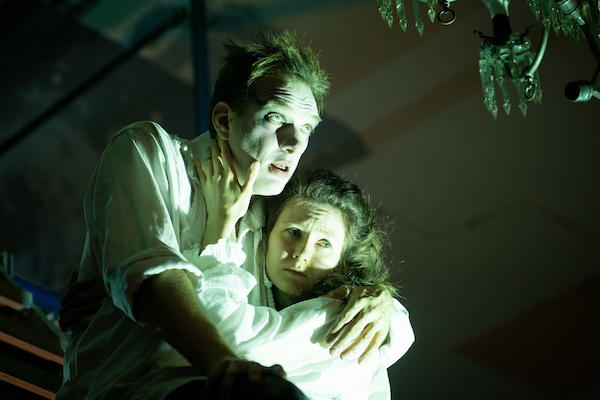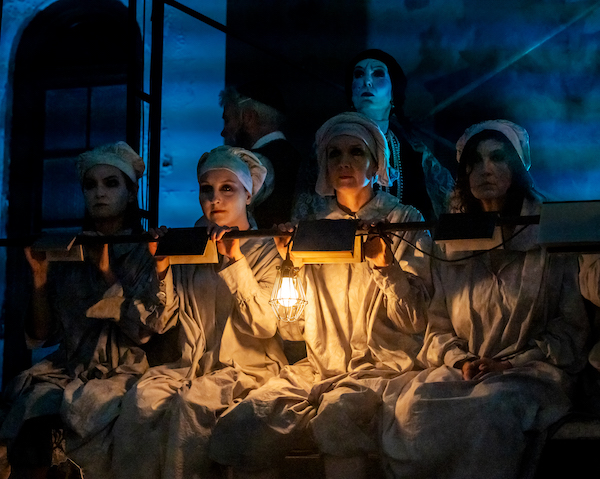Theater Review: A Magical, Risky, Reimagined Production of “The Dybbuk”
By Debra Cash
Arlekin Players Theatre’s The Dybbuk may not convince you of the supernatural, but director Igor Golyak is a magician.
The Dybbuk: between two worlds. Written by Roy Chen, based on the original play by S. Ansky, adapted by Igor Golyak with Dr. Rachel Merrill Moss with additional material from the translation by Joachim Neugroschel. Directed by Golyak. Produced by Sara Stackhouse. Staged by the Arlekin Players Theatre at the Vilna Shul, Boston, through June 30.

Andrey Burkovskiy and Yana Gladkikh in the Arlekin Players Theatre production of The Dybbuk: between two worlds. Photo: Irina Danilova
All buildings under renovation are haunted. Whether it’s a small repair or a building taken back to the studs, rebuilding requires examining the structures and traces of past times, and the fraught determination of what to retain.
Which is why Boston’s Vilna Shul deserves top billing in the Arlekin Players’ risky, reimagined production of The Dybbuk. Crammed with three-story scaffolding, scraped-off plaster, wafting plastic sheets, klieg work lights, and a star-of-David chandelier that throws shadows on the ceiling shaped like amputated human hands, the venue feels like liminal space. As soon as the Russian-speaking ushers escort you to your place on a wooden pew, there’s an immediate sense of disruption and of choices not yet concluded. The action of Arlekin’s Dybbuk takes place near at hand and far above your head; actors signal across space with mirrors as well as their voices. This is a Dybbuk that genuinely takes place between two worlds.
The original plot of The Dybbuk is one of love persisting beyond the grave. Leah and Khonen have been betrothed before their births but, when they come of age, Leah’s father Sender agrees to marry her off to a wealthier suitor. Khonen, calling on mystical powers, dies, but under the wedding canopy he possesses Leah as a disembodied spirit, a dybbuk. A rabbi conducts an exorcism, but the released Leah chooses to unite with her lover in death.
Director Igor Golyak moved to the Boston area from Russia in 1990 when he was 11 and has said that the idea of directing Ansky’s (sometimes written as An-ski) play had been in his back pocket for years. Written in Russian between 1913 and 1916, and then translated into celebrated Yiddish and Hebrew versions, The Dybbuk was based in part on Ansky’s ethnographic research into the folklore — and superstitions — professed in the tiny Jewish towns of the pale of Settlement (what is now primarily Russia and Ukraine). Working with playwright Roy Chen, this Dybbuk has been rebalanced and reshaped to toggle between a reverential 1920s sensibility and a 2024 one.
Andrey Burkovskiy, as the dybbuk in his restless state, skitters across the scaffolding in the play’s first minutes (there will be literal enactment of “the soul plunging from upmost heights to lowest depths”). His face is plaster white, his suspenders sag. The sounds of water plunk into galvanized buckets. His beloved, Leah (Yana Gladkikh), is a rag doll with rouged cheeks and dark braids, a sulky, impetuous teenager apt to blow her nose on her wedding veil. As Khonen/the Dybbuk and Leah, Burkovskiy and Gladkikh’s chemistry is palpable: both actors are graduates of the Moscow Art Theatre School and their mannered portrayals share an over-the-top silent film expressionism.

Dead souls in the Arlekin Players Theatre production of The Dybbuk: between two worlds. Photo: Irina Danilova
In Chen’s reworking, Leah is no longer a girl whose future is set at the whims of male society. When Leah is possessed by Khonen under the wedding canopy and bellows “you are not my bridegroom” it seems less that Khonen is speaking through her than that she is releasing pent-up fury. She’s grabbing her one chance at independent action. Her grandmother Frade (Deb Martin), draped in as many pearls as Coco Chanel and chewing up scenery like a Yiddishe Cruella de Vil, takes on exorcism duties with a cackle and a bundle of sage (hey, this is an American production, why not.) Too many things in this Dybbuk take place at a fever pitch and fortissimo — I imagine that anyone not familiar with the play before attending might have some trouble following who is, in fact, meant to be dead, and who is alive at any given moment — but Golyak’s images resonate.
Arlekin’s production seems to have adapted some of its visual language from the 1937 Yiddish film version directed by Michał Waszyński in Poland, which itself followed the design (and some of the gestural) direction of the famous Habima Hebrew language production directed by Stanislavsky protégé Evgeny Vakhtangov presented in Moscow in 1922. (Maxim Gorky saw a dress rehearsal and was impressed.) Yet Golyak is not afraid to scatter in a few fun, and funny, contemporary touches throughout the production, such as when the lovers declare their intentions accompanied by some indelible 1978 pop, and a character consults a book to perform CPR.
Arlekin’s The Dybbuk may not convince you of the supernatural, but Igor Golyak is a magician.
Debra Cash is a founding Contributing Writer to the Arts Fuse and a member of its Board. Long ago, her undergraduate thesis explored theater and dance versions of The Dybbuk.
Tagged: Andrey Burkovskiy, Arlekin Players, Igor Golyak, S. Ansky, The Dybbuk: between two worlds
